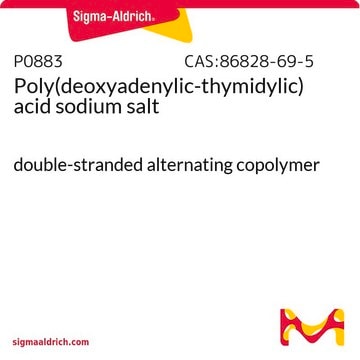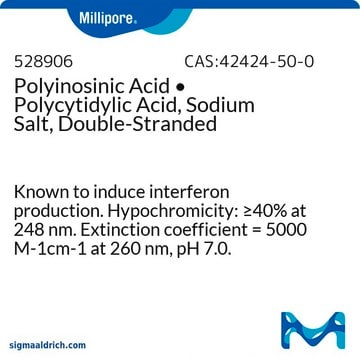The product specification does not include a base pair length, and it is not determined in quality control testing. The best estimate is that the polymer is a mixture of different lengths ranging from 150 base pairs to 2,000 base pairs. Users requiring more specificity of the base pair lengths may need to determine it using gel electrophoresis.
P1537
Polyadenylic acid-Polyuridylic acid sodium salt
double-stranded homopolymer
Synonyme(s) :
Poly[A]•Poly[U]
Sélectionner une taille de conditionnement
Sélectionner une taille de conditionnement
About This Item
Produits recommandés
Niveau de qualité
Forme
powder
Température de stockage
−20°C
Chaîne SMILES
[P](=O)(OC[C@H]3O[C@H]([C@@H]([C@@H]3O)O)[n]4c5ncnc(c5nc4)N)(O)O.[P](=O)(OC[C@H]1O[C@H]([C@@H]([C@@H]1O)O)N2C=CC(=O)NC2=O)(O)O
InChI
1S/C10H14N5O7P.C9H13N2O9P/c11-8-5-9(13-2-12-8)15(3-14-5)10-7(17)6(16)4(22-10)1-21-23(18,19)20;12-5-1-2-11(9(15)10-5)8-7(14)6(13)4(20-8)3-19-21(16,17)18/h2-4,6-7,10,16-17H,1H2,(H2,11,12,13)(H2,18,19,20);1-2,4,6-8,13-14H,3H2,(H,10,12,15)(H2,16,17,18)/t4-,6-,7-,10-;4-,6-,7-,8-/m11/s1
Clé InChI
VGQHQOKIMNKUEF-ZLOOHWKQSA-N
Application
Autres remarques
Code de la classe de stockage
11 - Combustible Solids
Classe de danger pour l'eau (WGK)
WGK 3
Point d'éclair (°F)
Not applicable
Point d'éclair (°C)
Not applicable
Équipement de protection individuelle
Eyeshields, Gloves, type N95 (US)
Faites votre choix parmi les versions les plus récentes :
Certificats d'analyse (COA)
Vous ne trouvez pas la bonne version ?
Si vous avez besoin d'une version particulière, vous pouvez rechercher un certificat spécifique par le numéro de lot.
Déjà en possession de ce produit ?
Retrouvez la documentation relative aux produits que vous avez récemment achetés dans la Bibliothèque de documents.
Les clients ont également consulté
-
What is the average base pair length for this product
1 réponse-
Utile ?
-
-
I'd like to know the homogeneity of this product, or at least the % A:U base pairing. My application is sensitive to high mismatch and single strand RNA content and I'm hoping this is at least 85% A:U base paired.
1 réponse-
Unfortunately, the homogeneity and A:U ratio are not determined for this product. The material is prepared by separately preparing polyA and polyU strands by an enzymatic method. The individual polyA and polyU strands are purified to remove low molecular weight species then annealed by heating, followed by a slow cooling process. Historical information indicates an approximate starting ratio of 1:2 molar concentration of Poly(A) to Poly(U), respectively. There is an estimated sodium content of 5 - 6%.
Utile ?
-
Filtres actifs
Notre équipe de scientifiques dispose d'une expérience dans tous les secteurs de la recherche, notamment en sciences de la vie, science des matériaux, synthèse chimique, chromatographie, analyse et dans de nombreux autres domaines..
Contacter notre Service technique









